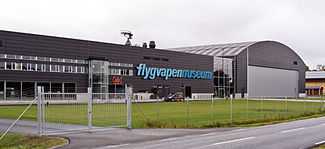Swedish Air Force Museum
| Swedish Air Force Museum | |
|---|---|
| Flygvapenmuseum | |
 | |
| Established | 1984 |
| Location | Malmen Airbase, Linköping |
| Website | http://www.flygvapenmuseum.se |
The Swedish Air Force Museum (in Swedish, Flygvapenmuseum) is located at Malmen Airbase in Malmslätt, just outside Linköping, Sweden. Malmen is where Baron Carl Cederström, nicknamed the "Flyer Baron" founded his flying school in 1912. Malmen Airbase is home to the Royal Swedish Airschool operating SAAB 105 (SK60) jet trainers. Along with the Swedish Army Museum (Armémuseum) in Stockholm, Flygvapenmusem constitutes the government agency Statens försvarshistoriska museer ("Swedish Museums of the Defence Forces").[1]
History
The museum’s collection of artefacts includes aircraft, engines, instruments and uniforms. The museum has a knowledge centre (faktarum), with library and archives, containing literature, periodicals, plans, photographs and personal files relating to aviation. The museum is part of the National Swedish Museums of Military History,[2] a government agency. The establishment of the Swedish Air Force Museum was also aided by the Östergötland Society for Aviation History (ÖFS).[3] Today, ÖFS acts as a support organisation for the museum, and actively works at tasks such as the restoration of aircraft.
The museum has been in existence since 1984, and served both as the F 3 Malmslätt squadron museum and a storage building in Ryd. The inauguration of the museum in 1984 marked the beginning of a public aviation museum at Malmen – the cradle of Swedish aviation. In 1989, the museum underwent an additional expansion with a second exhibition hall, enabling it to exhibit a large collection of aircraft from the decade following 1910 to today’s JAS 39 Gripen.
Design and facilities
In 2010 the museum had a major expansion and rebuild. The exhibitions are now divided in themes,[4] for example: 1. Pioneers in aviation, describing the early developments in Swedish aviation history in the period 1910 - 1926. 2. Between the wars, describing the establishment of the Swedish Airforce and the early developments of the Swedish aviation industry in the period 1926 - 1939. 3. The Second World War, when the Swedish Airforce increased in size and the first SAAB planes joined in the period 1939 - 1945. 4. Aviation technology 5. Sweden during the Cold War, showing preparations made in case of war in the period of the 1950s - 1980s.
The various exhibitions including the displayed aircraft are shown on three levels in the museum. There are two large hangar sized exhibition halls with a large number of aircraft and a third downstairs showing the DC-3 that was shot down in 1952 and eventually found in 2003. After interim storage, the plane was placed in its final location at the Swedish Air Force Museum on 13 May 2009.[5]
There is a Restaurant and Cafe, (Calle C Restaurang & cafe), at the museum. Across the road from the museum there is a parking lot.
Awards
The Air Force Museum won the award for the 2011 Swedish Museum of the year.[6] The Air Force Museum also won the prize for the 2010 Exhibition of the Year. The 2011 Swedish Museum of the Year award is sponsored by the Swedish chapter of the International Council of Museums (ICOM) [7] and the Association of Swedish Museums. The award for the 2010 Exhibition of the Year is sponsored by FORUM for exhibitors.
Collection

A German built Junkers Ju 86 twin-engined bomber (the only one left in the world), and a wide range of British, American, Italian and Swedish-made aircraft (among others) reveal the diversity of types flown by the Swedish Air Force including aircraft from every stage of Swedish military aviation. Noteworthy exhibition objects from the pioneering days of World War I include an Albatros B.IIa (Sk 1 or Ö2) trainer, as well as Nieuport and Bréguet combat aircraft. All service aircraft of significance from the post-war years are exhibited, from the Saab J 29 "Flying Barrel", a sturdy fighter of the 1950s, to the contemporary 4th generation multirole fighter JAS 39 Gripen. Recently, new exhibitions have been added, based around the salvaged Tp 79 (Swedish Air Force designation for C-47) ELINT aircraft, shot down by a Soviet MiG-15 in 1952. There is also a Saab 39 Gripen simulator in the museum. Just outside the museum an English Electric Canberra (Tp 52), Vickers Varsity (Tp 82) and Douglas C-47A Skytrain (Tp79) are on display but not yet fully restored. Recently, there was also a Hunting-Percival Pembroke (Tp83) outside the museum. However, this has been moved for restoration.
Displayed in the main exhibition halls
|
External DisplayIn storage or under restoration
|
See also
References
- ↑ http://www.sfhm.se/default____4443.aspx?epslanguage=SV
- ↑ http://www.sfhm.se/smha/ListPage____2253.aspx?epslanguage=EN
- ↑ http://www.ofsflyg.se/
- ↑ http://www.flygvapenmuseum.se/en/See-and-Do/Exhibitions/Swedish-military-aviation/
- ↑ http://www.flygvapenmuseum.se/en/See-and-Do/Exhibitions/Acts-of-Secrecy/To-the-museum/
- ↑ http://icomsweden.se/2011/04/flygvapenmuseum-utsett-till-arets-museum/
- ↑ http://icomsweden.se/english/
External links
| Wikimedia Commons has media related to Swedish Air Force Museum. |
| ||||||||||||||||||||||
Coordinates: 58°24′36″N 15°31′25″E / 58.41000°N 15.52361°E